Living Behind the Face Mask
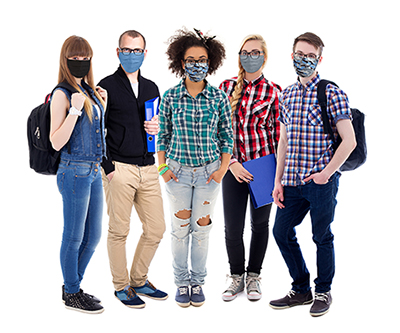
Times have changed. Common activities such as gathering with friends and family or merely going out to the grocery store are not as simple as they used to be. Now the protective face mask has become an important item to have with us at all times. It’s up there with our keys, wallet and driver’s license. We have them hanging from the rearview mirrors in our cars ready to grab at every stop with extras in the glove compartment. They’ve even become somewhat of a canvas for communication, with logos of our favorite companies and products and messages expressing our support for some initiative or point of view, much like we do with T-shirts.
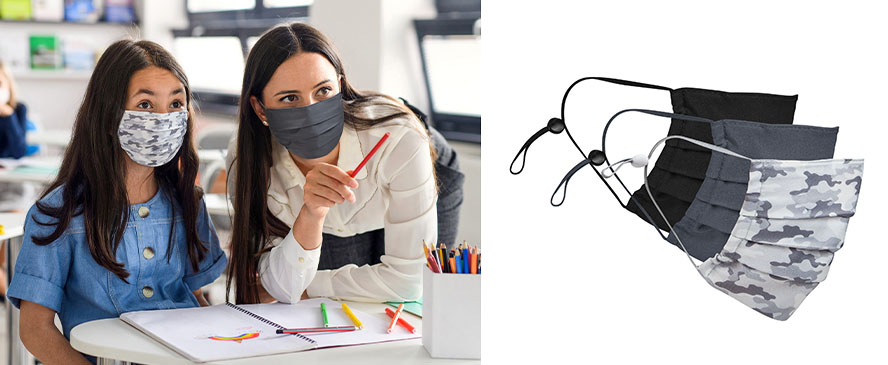
Wearing protective face masks has given rise to all kinds of questions and controversies. Masks have also created issues associated with concerns such as hair and skin care. Have you heard about or experienced the newest type of acne known as “maskne”? Read on! We’ll talk about it along with some other mask-related problems and suggestions for better living behind the face mask.
Why Are We Wearing Masks?
According to the Centers for Disease Control and Prevention (CDC), masks are an additional step to help slow the spread of COVID-19 when combined with everyday preventive actions and social distancing in public settings.1 Now both the CDC1 and the World Health Organization2 (WHO) recommend high-quality cloth masks for everyone entering densely occupied public places. For the latest news and advice related to COVID-19, refer to the websites of the CDC and WHO.
Where Can I Get a Mask?
The primary consideration in choosing a mask is that it cover both the nose and the mouth. Comfort is important in situations where the mask must be worn for extended periods of time. The ideal face mask is one that can block large respiratory droplets expelled by coughing and sneezing and the smaller airborne particles produced when people talk or exhale.
The most effective masks for filtering our viral aerosols and particles are medical grade masks, such as the notorious N95 and N99. Both of these seal tightly around the nose and mouth preventing all but a tiny fraction of seepage around the perimeter of the mask. These masks are also made with a web of tangled fibers at high density to effectively filter airborne pathogens.
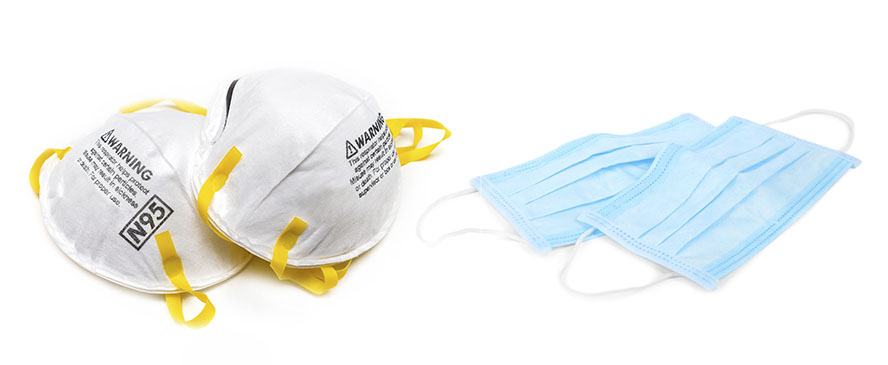
Conair® offers a collection of high-quality protective, reusable, double-layer cloth face masks in a variety of styles and colors. Fashioned from ultra-soft fabric, these everyday pleated, surgical-style masks provide 2 layers of protection while maintaining maximum comfort. And because they're machine-washable, you can use them over and over again. Take a look at the Travel Smart® by Conair 3-Pack Face Masks and 5-Pack Face Masks on the Conair website.
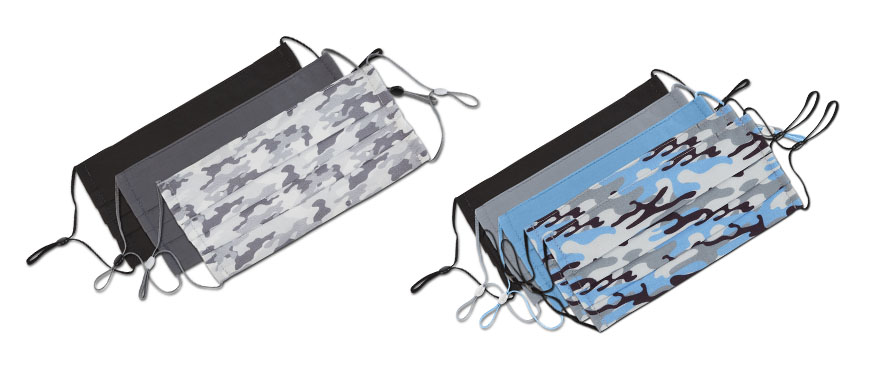
How to Wear a Mask Correctly
If you’ve noticed the way some people wear their masks, you might conclude that they think of a mask as little more than a good luck charm—loosely worn with the nose exposed or hanging below the chin. The procedures required to properly wear a mask are simple and easy to follow.
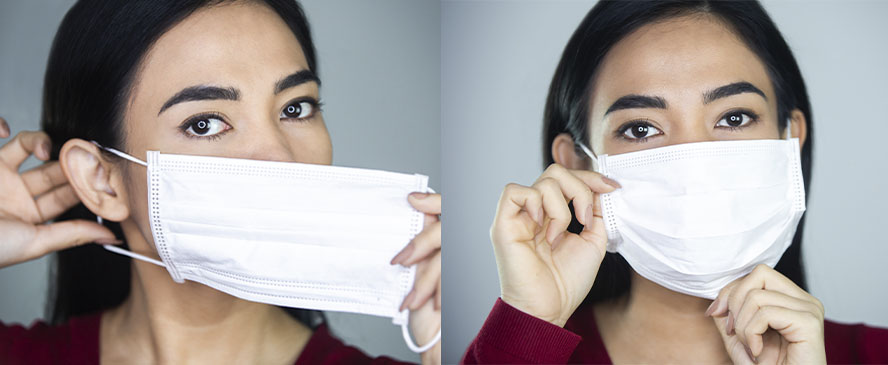
The more common types of masks being used today have elastic strings that hook behind your ears. Some, like some versions of the cup-shaped N95, have two strings or elastic ties that go behind your head. Whichever type you prefer, try to handle the mask mostly by the strings or ties. Touch the mask cover as little as possible, and completely refrain from touching the inside of the mask cover. The key is to make sure the mask fits properly by having contact with your face around the entire perimeter of the mask. Putting on a cup-shaped mask with ties or loops that go behind the head can be a little more challenging. Here are some guidelines for putting on both types of masks:
Suggested guidelines for putting on an ear-loop mask:
- Start with clean hands. Wash or use sanitizer before handling your mask.
- Handle your mask by the strings or elastics as much as possible.
- Pull the mask open horizontally.
- Tuck the bottom edge of the mask under your chin.
- Lift up on the elastics to extend the mask vertically above your nose.
- Pull the elastics back and hook them behind your ears.
- Make adjustments to the fit by pinching the edges of the mask with your thumb and forefinger and adjust to a snug seal.
- If your mask has a wire reinforcement at the bridge of your nose, press it down to mold it to the shape of your nose creating a snug seal.
Suggested guidelines for putting on cup-shaped masks with behind the head loops:
- Start with clean hands. Wash or use sanitizer before handling your mask.
- Hold the mask in the palm of your hand with the inside facing up and the nose piece facing away from you. Let the head straps hang freely and untwisted below your hand.
- Place the mask under your chin and over your nose.
- While holding the mask in place with one hand, pull the top loop over your head and position it high on the back of your head.
- Pull the bottom loop over your head and position it around your neck below your ears. If you have long hair, make sure the elastic loop rests under the hair on the skin of your neck.
- Untwist the straps so they lie flat.
- Mold the nose piece to the shape of your nose to get a snug seal.
Dealing with Maskne, Messy Hair and More
While there are benefits to wearing a mask, there are some comparatively minor nuisances to mask wearing that we didn’t expect when the need to wear them first started. These little drawbacks can be remedied quite effectively with some simple techniques.
Skincare and the Rise of “Maskne”
Some people, especially those with sensitive skin, have discovered that wearing a mask appears to cause breakouts of blemishes around the mouth and chin. When you breathe and talk with a mask on, moisture and heat become trapped—a perfect environment for bacteria, skin mites and dust to accumulate. The result for some of us is “maskne” or mask-related acne.
>Maskne is a condition that can be addressed with some simple routine skincare practices. Pay a little more attention to facial cleansing using mild facial cleansers and a good quality, soft facial brush. A good example of such a brush is the True Glow® Battery-Operated Facial Brush. It gently removes dirt, oil and makeup, and includes 3 brush attachments to clean, exfoliate, moisturize and massage.
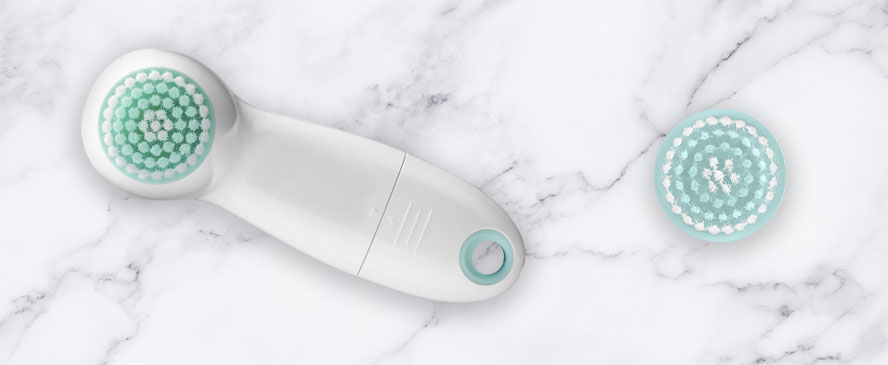
A periodic deep cleansing of the skin can be achieved with moisturizing mist from a facial sauna. Warm steam opens the pores allowing oils and dirt to be cleansed away. One of the better methods of achieving such a facial sauna at home can be had with the affordable True Glow® Moisturizing Mist Facial Sauna System. It uses a 3-step approach for opening pores, deep cleansing and moisturizing that can be exceptionally effective in preparing your skin for the next steps in your personal regimen. In addition to taking on the maskne problem, it can hydrate your skin and diminish the appearance of aging and damage caused by the sun and dry environmental conditions. The kit comes with a powered facial cleansing brush that’s battery-operated and 2 brush attachments.
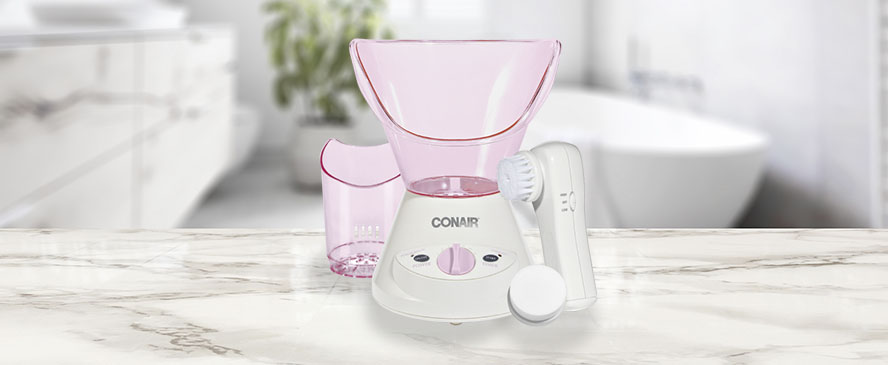
Other useful skincare tools to help fight maskne are the True Glow® Skinpod Silicone Cleansing Brush and the True Glow® Disposable Facial Pod. These handy skin cleansers are small enough to take with you. The Skinpod is a powered sonic pod that features 3 cleansing zones to combat a variety of skincare issues. It’s water resistant and safe to use in the shower.
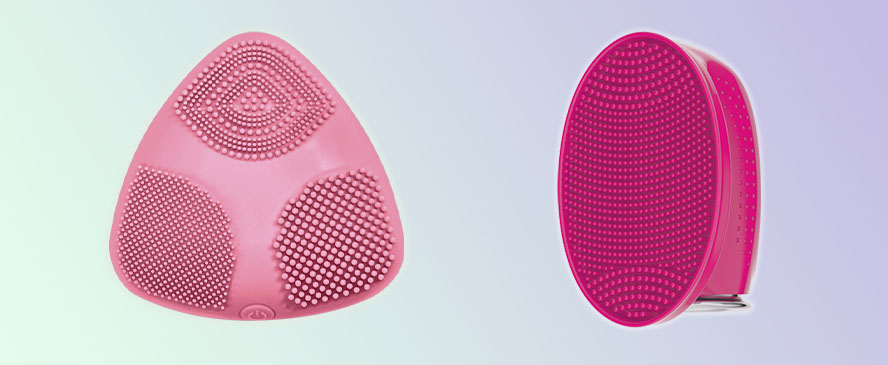
and the True Glow Disposable Facial Pod (FCB9)
The Disposable Facial Pod is an economical water-resistant mini facial brush that provides a daily cleansing treatment that helps fight maskne and leaves your skin deeply cleansed. See it on the Conair website. The gently vibrating bristles remove dirt and makeup from your pores with no irritation. Perfect for all skin types, each brush is good for up to 120 cleansings before disposal.
Oral Hygiene for a Breath of Fresh Air
The same conditions that affect your facial skin when wearing a mask can exist inside your mouth. Elevated temperatures and trapped bacteria are a breeding ground for bad breath and may create an environment more conducive to tooth decay. Maintaining or even improving your oral hygiene routine should be a necessary lifestyle enhancement during these times.
To help take your oral hygiene ritual to a higher level, consider a water jet. The Interplak® by Conair Classic Water Flossing System cleans between the teeth and below the gum line using a high-pressure stream of water to help prevent gingivitis and gum disease. It’s safe for use on all dental work, including braces.
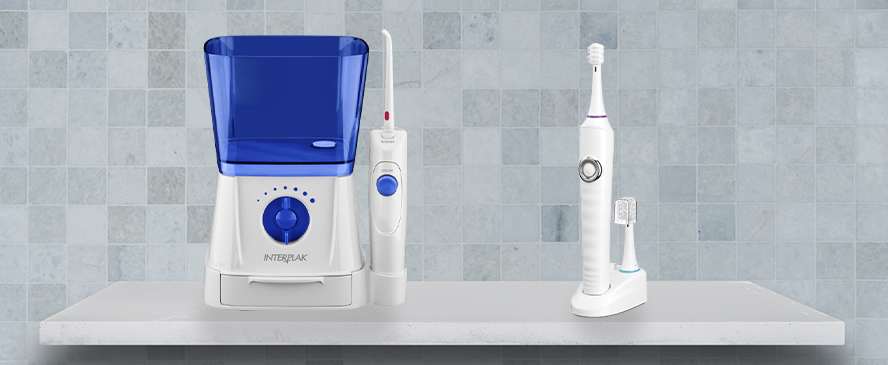
Step up from an ordinary toothbrush and reap the benefits of this revolutionary leap in powered dental hygiene technology. The Interplak® by Conair Oscill8™ Rechargeable Toothbrush features 8 individually oscillating tufts of bristles. The oscillating bristles follow the contours of your teeth and gums, with the long tufts extending deep between teeth, and shorter tufts polishing flat surfaces. Brush heads are easy to remove and replace, and the comfort-grip design ensures comfortable brushing for hands of all sizes. A convenient stand with a water-resistant charging base holds and charges the brush.
Conquering Messy Face Mask Hair and Ear Fatigue
Another challenge that has arisen from our present-day necessity to wear protective face masks is the problem of messy face mask hair. Masks with strings or straps that go behind the head can create kinks and depressions in the hair. Plus, a constant putting on and taking off of the mask can produce tangles and general messiness especially for longer hairstyles. Quick-and-easy hair touch-ups when you’re on the go or dealing with second-day hair don’t have to be difficult or burdensome with the right hairstyling tools at your fingertips.
Consider the Unbound® Petite collection of styling tools from Conair. There’s a flat iron, multi-styler and straightening comb—all cordless and sized to fit in most any purse, backpack or carrying bag. You can knock out the kinks from hours of wearing a mask, then curl or straighten to restore a salon-quality style in minutes, whether you’re at the job, in the car or at the gym, anywhere. There are no cords to tie you down.
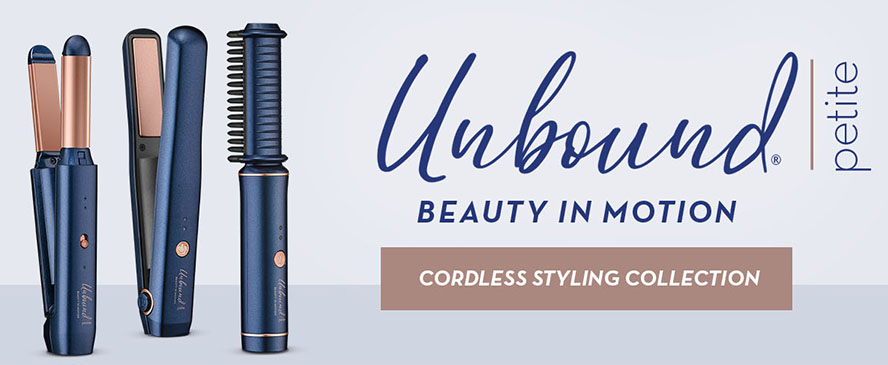
You can view the entire collection of Unbound® styling tools on the Unbound® microsite including the remarkable Unbound® Auto Curler that lets you create fabulous curls at the press of a button.
Another suggestion for quick styling and fixups in this age of the protective face mask is The Knot Dr.® All-in-One Dryer Brush from InfinitiPRO by Conair®. Detangle, dry, style, and volumize your hair—all with this one styling tool. Innovative detangling technology smooths away snags, and ionic technology reduces frizz. Freshen-up your style from mask-induced messiness and kinks quickly and easily. Ideal for all hair types, with 2 heat settings and a cool setting, plus a volumizing attachment. Check out the article In Search of the Best Hair Dryer Brush for more details on this exciting, new styling solution.
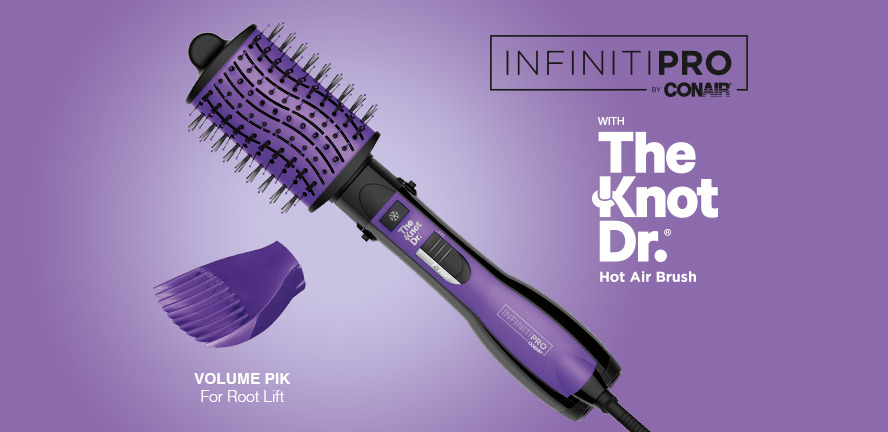
Masks that hook behind the ears can become uncomfortable after long periods of wearing the mask. With some clever hairstyling tricks, ear fatigue can be easy to relieve. You can make or purchase a mask extender that uses buttons to hold the mask straps on the back of your head. Scunci® offers a headband with buttons that offers a similar solution. Plus, you can style in ways that can conceal or accommodate mask straps more effectively.
Ear-Saving alternatives:
- Make a headband with buttons: An ordinary cloth headband with buttons sewn onto the sides just above the ears can hold the ear loops from a mask in place. No pressure on the ears anymore! See the headband with buttons from Scunci®
- Make a strap with buttons: A cloth strap around 6 to 8 inches long with buttons sewn onto each end is another ear-saving accessory that’s easy to make. The strap is positioned on the back of your head and the mask loops hook onto the buttons.
- Create a mask-friendly hairstyle: Hairstylists have been hard at work creating new hairstyling techniques that are easy to maintain and conceal the strings and loops that hold masks on and relieve the ears from irritating elastic straps. You can find a variety of instructional videos online that can show you how to style for the mask.
Just search the internet for “mask extenders,” “mask headbands” or “mask hairstyles” for lists of videos that will show you how to take advantage of these ear-saving alternatives for mask wearing.
With masks going on and off all day long for some of us, quick hair touch-ups on the go have become a bit of a necessity. To knock out links and tangles, a hairdryer and a damp brush can get the job done. A high-performance dryer, such as the InfinitiPro by Conair® Smoothwrap™ offers advances in technology that set it apart in the hairdryer marketplace. Its dual ion therapy maximizes a more balanced absorption of conditioning ions—a combination of positive and negative ions to rebalance the natural charge of your hair. You get more body and volume with less frizz from frequent usage. It leaves hair feeling silky and healthy with a luxurious shine.
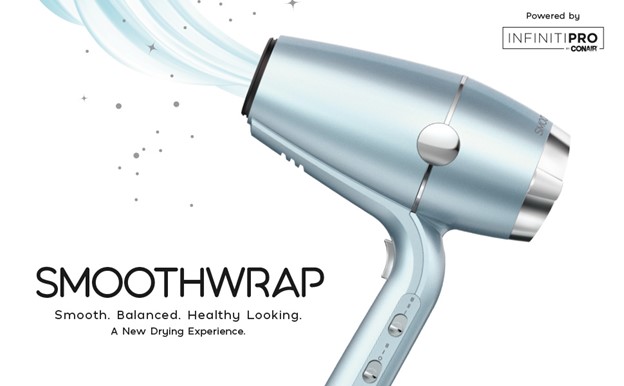
What About Men with Beards?
Facial hair that lies along the sealing area of a protective face mask, such as beards, sideburns and some mustaches, can interfere with a mask’s fit. There are several different style choices for facial hair that don’t interfere with a mask making a good fit on the face. The best alternative, if possible, is to go clean shaven.
For a comprehensive look at the issue of mask wearing with facial hair and beards, check out the article To Beard or Not to Beard? That’s a Good Question! on the CDC website. It even includes an infographic that depicts all of the variations in facial hair styling and identifies those to avoid for the safest use of a protective face mask.
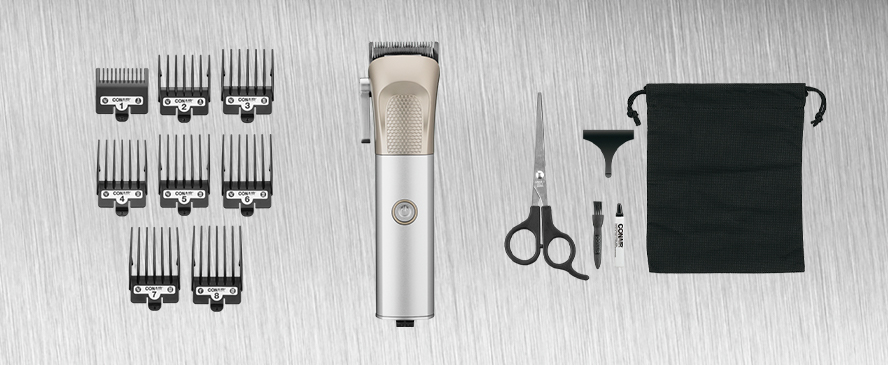
If you don’t want to shave it all off but prefer to maintain some type of facial hair styling under your protective face mask, a good men’s grooming tool can be a big help. The ConairMan® Metalcraft High Performance Metal Clipper is just such a solution. Designed with a sleek metal handle and Japanese stainless steel blades for precise cuts, this must-have men’s grooming tool gets the job done right. Powered by a high-torque, professional DC motor and equipped with a 6-foot cord that gives you room to maneuver, it includes 8 guide comb attachments that let you customize your cut. In addition to giving yourself a great haircut, it’s great for trimming sideburns to keep them from interfering with the mask elastics.
Conair features a broad selection of hair clippers, hair trimmers and personal groomers to keep facial hair in check. Visit the men’s grooming section on the Conair website for complete details.
How to Clean and Store Reusable Masks
Reusable masks should be washed regularly. The CDC recommends machine washing or washing by hand after every use for maximum safety and protection—at least daily if worn in a public environment. Try to remove your mask holding the straps only and place into the washing machine or hand-wash basin immediately after removal. Don’t touch any part of your face, especially your eyes, nose or mouth, until you have washed your hands or used hand sanitizer.
Check to see if a label on your mask has any particular washing instructions you should be aware of. Masks can be machine washed along with your regular laundry using common laundry detergents in warm water. If washing by hand, it is recommended that you soak cloth masks in a bleach solution, one-third cup of bleach to one gallon of water, for at least 5 minutes, and be sure to rinse them thoroughly.
You can dry masks in your clothes dryer along with the rest of your laundry using the highest heat setting. Just make sure masks are completely dry before use or storage. Mold can develop in partially dry fabrics. To air-dry a mask, lay it flat, preferably in direct sunlight, and flip it over to make sure both sides are completely dry.
For the latest news and advice related to COVID-19, refer to the websites of the CDC and WHO.
This article does not constitute medical advice. Please consult your physician if you have any health concerns related to COVID-19 risk.
1Centers for Disease Control and Prevention, https://www.cdc.gov/coronavirus/2019-ncov/prevent-getting-sick/how-to-wear-cloth-face-coverings.html
2World Health Organization, https://www.who.int/emergencies/diseases/novel-coronavirus-2019